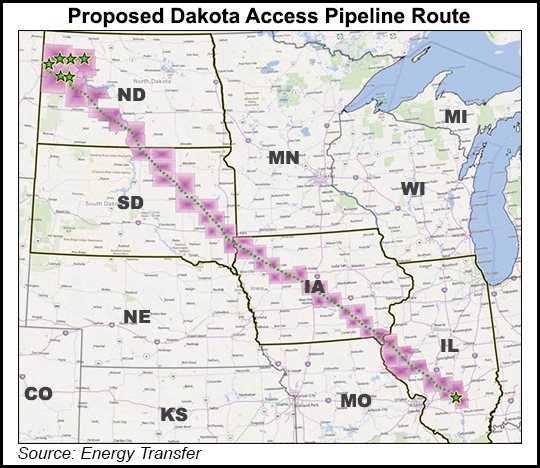Shale Daily | Bakken Shale | E&P | Infrastructure | NGI All News Access
Dakota Access Pipeline Construction Sits Uneasily in Federal Hands
Whether construction of the $3.8 billion, nearly 1,200-mile Dakota Access oil pipeline is completed on schedule early next year will likely be determined by a volatile amalgam of political, regulatory and court actions that should culminate in the next two or three weeks, based on developments in federal court Friday.

Judge James E. Boasberg of the Federal District Court for the District of Columbia declined to continue a temporary restraining order (TRO) that was in place until a status conference Friday. In that TRO, Dakota Access had voluntarily agreed to halt construction activities within two miles of the western edge of Lake Oahe and 20 miles east of the lake.
“The company’s plans in the wake of the judge’s decision were not made known at the hearing, but it appears that there are no longer any judicial restrictions — voluntary or involuntary — that would keep Dakota Access from construction activities not taking place in any area other than the land associated with the U.S. Army Corps of Engineers’ (USACE) easement for the utility crossing immediately proximate to Lake Oahe,” said Christi Tezak, managing director at ClearView Energy Partners LLC.
In North Dakota on the same day, U.S. District Court Judge Daniel Hovland removed another TRO — this one against Standing Rock Sioux Tribal Chairman Dave Archambault II, Councilman Dana Yellowfat, and a number of other protesters opposed to the four-state oil pipeline. Dakota Access LLP applied the TRO on Aug. 15 in an effort to cut off demonstrations that they alleged had effectively shut down construction near the Oahe crossing under the Missouri River near the reservation in southcentral North Dakota.
Hovland’s action eliminated any federal court prohibition on protests against the pipeline, leaving it up to local authorities and the criminal courts to deal with those accused of violations.
Meanwhile, local authorities are charging as felonies nonviolent actions, such as protesters locking their bodies to stationary equipment. An attorney representing some of the protesters said that while Hovland said he disliked many of the tactics of the protesters, he recognized the limitations of a court injunction in resolving a political contest like the one involved in the pipeline dispute.
Outside of the courts, the USACE’s easement for completing the pipeline work under Lake Oahe continues to be a key unknown, although Corps officials reportedly told Boasberg that a decision on the easement is a matter of weeks away — not months. A quick granting of the easement is thought to be a way for Dakota Access to remain on it most favorable construction completion timetable for early next year.
Tezak noted that the 8th Annual White House Tribal Nation’s conference is scheduled to be held in Washington, DC, Sept. 26-27. “This venue may present an opportunity to at least initiate the ‘government-to-government’ consultations promised by Justice, Interior and the Army in their joint announcement on Sept. 9.
“At first blush, the Corps statement could suggest that easement could be issued soon, potentially allowing Dakota Access to complete the pipeline section under Lake Oahe this fall,” she said.
Tezak said ClearView’s analysis remained “cautious,” given the precedent of the rejected Keystone XL pipeline, a project which was subject to “several supplemental reviews.” In the case of Dakota Access, the Corps could decide to reopen the environmental review of the lake crossing, EPA review or revisit another component of the completed review under either the Clean Water Act, the Rivers/Harbors Act,or the National Historic Preservation Act. Any of those courses would likely delay the USACE easement being issued.
The Corps’ response to the Standing Rock Sioux’ complaint is due on Oct. 11, and a further status conference will be held on Nov. 10. In the meantime, the Standing Rock Sioux tribe is still seeking an emergency injunction to overturn Boasberg’s past rulings and to halt pipeline construction on a 20-mile portion on either side of Lake Oahe.
Energy industry and construction trades officials have pushed back against the Obama administration’s eleventh-hour interference in the Dakota Access project (see Shale Daily, Sept. 13).
© 2024 Natural Gas Intelligence. All rights reserved.
ISSN © 2577-9877 | ISSN © 2158-8023 |
